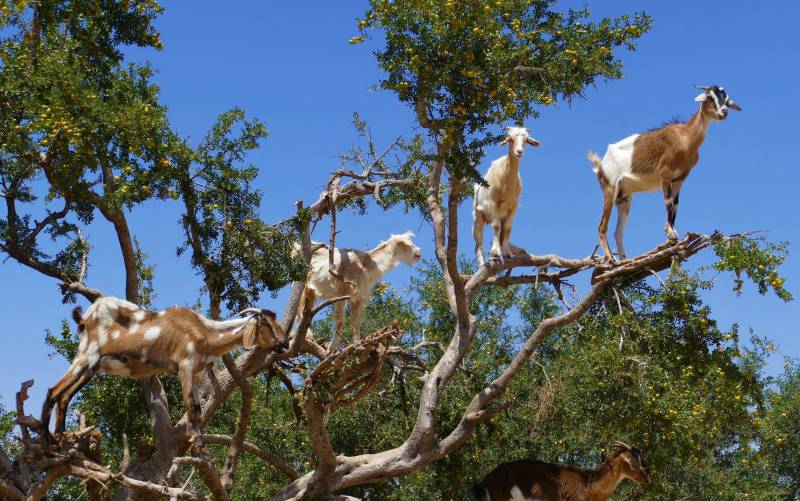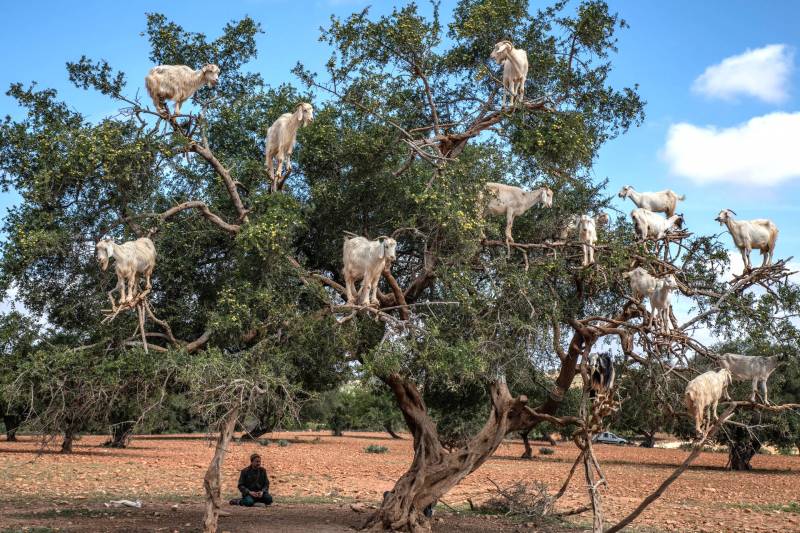Quick Navigation
Goats are beautiful animals that provide meat and milk, but some of their characteristics can perplex humans, like why goats climb trees while other domesticated animals with hooves can’t.

A horse, cow, or donkey cannot climb trees or steep rocks.
If you’re wondering why your goat is climbing trees, this article will uncover why.
Here are some of the main reasons:
Goats Climb Trees In Search Of Food
The main reason why goats climb trees is they are searching for food.
This is because goats are active foragers able to cover a broader area in search of scarce plant materials.
Since goats have small mouths, narrow muzzles, and split upper lips, they can easily pick tiny leaves, fruits, flowers, and other parts of the plant.
As a result, goats only choose the most nutritious available feed.
Being natural browsers, goats can choose most of their daily diet if given a chance.
They love feeding on brush & woody perennials and broadleaf plants over herbaceous species, like orchardgrass, bermudagrass, and much more.
That’s why you will see goats climbing trees to feed on the leaves, fruits, bark, or even flowers.
Some goats cannot climb trees but stand on their hind legs and stretch to browse tree leaves or throw their bodies against saplings to bring the top of small trees within their reach.
In short, a goat can climb trees or stand on its hind legs to consume the desired forage.
Goats climbing trees are common in Morroco, Algeria, and Mexico.
Goats Climb Trees To Evade Predators
One of the challenges of raising goats is to keep them away from predators.
And as an owner, you want to ensure that your goats are always protected and safe.
If you live near a forest, there is a high chance that goat predators such as coyotes, wolves, and foxes will be after your goats.
And one way the goats protect themselves is by climbing on top of trees where most predators can’t reach them.
So, if you see your goats usually up in the trees but not feeding on them, you should find out the issue.
You may have coyotes or wolves in your area that you don’t know about.
Ensure the security is tight so the predators can’t reach your goats and other domesticated animals.
Goats Climb Trees To Watch Predators
Goats are prey animals.
Thus, they tend to get to higher places to watch for predators.
If you see a herd of goats browsing, you will notice that one is on higher ground, on top of a rock, or even on a tree surveying the area.
This signifies that the goat is the leader and is watching over the herd.
The goat that watches over other goats is usually the dominant female, or “queen” of the herd.
She will also stand up and protect the herd if a predator attacks.
So, if the area the herd is foraging doesn’t have higher ground but trees, the goat may climb on one of the trees to keep watch and alert other goats.
Where Are Goat Climbing Trees Found?
Even though goats that climb trees are not everywhere, they are common in Morocco.
However, if you want to see them, you must travel to the country’s Souss Valley, near the southern city of Taroudant.
This is the same route from the city of Marrakech to the coastal town of Essaouira.
Argan trees are common in this region, and you can also find them in the western parts of Algeria.
These trees may not be attractive, but they produce a fruit that looks like a shriveled olive and ripens yearly around June.

The goats in this area crave this fruit’s bitter taste and aroma.
As a result, they climb on these trees to feed on the fruit.
Besides craving this fruit, these goats climb these trees because of food scarcity.
With this in mind, these goats are left with no option but to climb on the argan tree in search of fruit.
The goats can climb up to the top of 30 feet tall argan trees.
Besides, the indigenous Berber tribe in this area encourages the goats to climb trees as they also benefit from the pulp in the fruit.
When the goat swallows the fruit, it passes through its digestive system and ends in droppings.
Since the goat’s digestive system softens the pulp, people find it easy to crack the nut and remove argan oil.
Aside from Morocco, goat-climbing trees can also be found in neighboring Western Algeria and Mexico.
How Do Goats Manage To Climb Trees?
Not all types of goats can climb trees.
Some breeds are good at climbing trees, while others are not.
For instance, the goats climbing trees in Morocco have adapted to climbing trees because of food scarcity.
However, some goat breeds are naturally good climbers.
An excellent example of such goats is mountain goats.
Goats are good at climbing trees because of their features.
Not only are goats good at balancing than humans, but they have slim bodies that allow them to maneuver easily over trees or even rocks.
And since their hooves are split into two sections, this allows them to have an excellent grip on surfaces.
The bottom of their hooves has rubbery pads that give them more even traction.
Furthermore, goats have two stubby “dewclaws” on the back of their legs that they use for gripping as they climb a tree.
With these features, it’s easy to see why many goats climb trees quickly.
Conclusion
Goats climb trees to feed, keep watch, or evade their predators.
Knowing this, you must provide your goat with enough food to keep it secure from predators.
Also, you should give it the proper diet, so it does not have to feed on your tree leaves, bark, or fruits.

Purrfect n’ Pawesome is the brainchild of Amanda, who has been into researching and writing about pets to help other pet parents in nurturing their adorable pets. Currently, she runs Purrfect n’ Pawesome along with her team of experienced and dedicated pet experts. Along with being an awesome writer and entrepreneur, Amanda is a cat mom to two innocently spoiled cats, Balanca and Scruffy.
She has been writing about pet care and nurturing and wants to share her readers’ experiences, learnings, and knowledge.
Over the years, she had the opportunity to work with various pet owners having multiple breeds, and that exposure gave her experience and the lessons of a lifetime.
Her family, her entire universe revolves around her two cats, who give her endless support and inspiration to move ahead with her objectives in life. Amanda is a live example of a balanced approach to all parenthood questions we all face in life.
